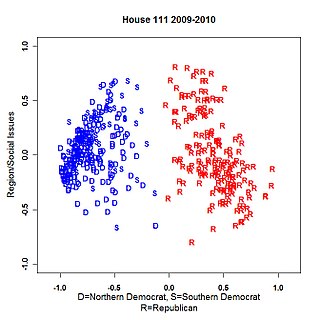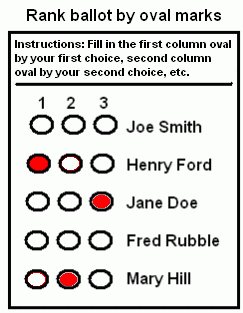Related Research Articles
A political spectrum is a system to characterize and classify different political positions in relation to one another. These positions sit upon one or more geometric axes that represent independent political dimensions. The expressions political compass and political map are used to refer to the political spectrum as well, especially to popular two-dimensional models of it.

The two-round system, also called ballotage, top-two runoff, or two-round plurality, is a single winner voting method. It is sometimes called plurality-runoff, although this term can also be used for other, closely-related systems such as ranked-choice voting or the exhaustive ballot. It falls under the class of plurality-based voting rules, together with instant-runoff and first-past-the-post (FPP). In a two-round system, both rounds are held under choose-one voting, where the voter marks a single favorite candidate. The two candidates with the most votes in the first round proceed to a second round, where all other candidates are excluded.

In social choice theory, Condorcet's voting paradox is a fundamental discovery by the Marquis de Condorcet that majority rule is inherently self-contradictory. The result implies that it is logically impossible for any voting system to guarantee a winner will have support from a majority of voters: in some situations, a majority of voters will prefer A to B, B to C, and also C to A, even if every voter's individual preferences are rational and avoid self-contradiction. Examples of Condorcet's paradox are called Condorcet cycles or cyclic ties.

Arrow's impossibility theorem is a key result in social choice theory, showing that no ranking-based decision rule can satisfy the requirements of rational choice theory. Most notably, Arrow showed that no such rule can satisfy independence of irrelevant alternatives, the principle that a choice between two alternatives A and B should not depend on the quality of some third, unrelated option C.

In social choice, the negative responsiveness, perversity, or additional support paradox is a pathological behavior of some voting rules, where a candidate loses as a result of having "too much support" from some voters, or wins because they had "too much opposition". In other words, increasing (decreasing) a candidate's ranking or rating causes that candidate to lose (win), contrary to common sense. Electoral systems that do not exhibit perversity are said to satisfy the positive response or monotonicitycriterion.

A Condorcet winner is a candidate who would receive the support of more than half of the electorate in a one-on-one race against any one of their opponents. Voting systems where a majority winner will always win are said to satisfy the Condorcet winner criterion. The Condorcet winner criterion extends the principle of majority rule to elections with multiple candidates.

The median voter theorem in political science and social choice theory, developed by Duncan Black, states that if voters and candidates are distributed along a one-dimensional spectrum and voters have single-peaked preferences, any voting method that is compatible with majority-rule will elect the candidate preferred by the median voter. The median voter theorem thus shows that under a realistic model of voter behavior, Arrow's theorem, which essentially suggests that ranked-choice voting systems cannot eliminate the spoiler effect, does not apply, and therefore that rational social choice is in fact possible if the election system is using a Condorcet method.
Peter Carl Ordeshook is an American political scientist. He is the Mary Stillman Harkness Professor of Political Science at the California Institute of Technology in Pasadena, California.
Political forecasting aims at forecasting the outcomes of political events. Political events can be a number of events such as diplomatic decisions, actions by political leaders and other areas relating to politicians and political institutions. The area of political forecasting concerning elections is highly popular, especially amongst mass market audiences. Political forecasting methodology makes frequent use of mathematics, statistics and data science. Political forecasting as it pertains to elections is related to psephology.

Instant-runoff voting (IRV) is a winner-takes-all multi-round elimination voting system that uses ranked voting to simulate a series of runoff elections, where the last-place finisher according to a plurality vote is eliminated in each round and the votes supporting the eliminated choice are transferred to their next available preference until one of the options reaches a majority of the remaining votes. Its purpose is to elect the candidate in single-member districts with majority support even when there are more than two candidates. IRV is most closely related to two-round runoff election.
A valence issue is a political issue where there is a broad amount of consensus among voters. As valence issues are representative of a goal or quality, voters use valence issues to evaluate a political party’s effectiveness in producing this particular goal or quality.

NOMINATE is a multidimensional scaling application developed by US political scientists Keith T. Poole and Howard Rosenthal in the early 1980s to analyze preferential and choice data, such as legislative roll-call voting behavior. In its most well-known application, members of the US Congress are placed on a two-dimensional map, with politicians who are ideologically similar being close together. One of these two dimensions corresponds to the familiar left–right political spectrum.
The term issue voting describes when voters cast their vote in elections based on political issues. In the context of an election, issues include "any questions of public policy which have been or are a matter of controversy and are sources of disagreement between political parties." According to the theory of issue voting, voters compare the candidates' respective principles against their own or rank the candidates' perceived competence on an issue in order to decide for whom to vote.

Ranked voting is any voting system that uses voters' rankings of candidates to choose a single winner or multiple winners. More formally, a ranked system is one that depends only on which of two candidates is preferred by a voter, and as such does not incorporate any information about intensity of preferences. Ranked voting systems vary dramatically in how preferences are tabulated and counted, which gives them very different properties.
There are a number of different criteria which can be used for voting systems in an election, including the following
The McKelvey–Schofield chaos theorem is a result in social choice theory. It states that if preferences are defined over a multidimensional policy space, then choosing policies using majority rule is unstable. There will in most cases be no Condorcet winner and any policy can be enacted through a sequence of votes, regardless of the original policy. This means that adding more policies and changing the order of votes can be used to arbitrarily pick the winner.

A major branch of social choice theory is devoted to the comparison of electoral systems, otherwise known as social choice functions. Viewed from the perspective of political science, electoral systems are rules for conducting elections and determining winners from the ballots cast. From the perspective of economics, mathematics, and philosophy, a social choice function is a mathematical function that determines how a society should make choices, given a collection of individual preferences.
Impartial culture (IC) or the culture of indifference is a probabilistic model used in social choice theory for analyzing ranked voting method rules.

Electoral competition, political competition or electoral competitiveness describes the amount of competition in electoral politics between candidates or political parties, usually measured by the margin of victory. The Polity data series includes a measure of political competition. Political competitiveness can be affected by the proportionality between votes and seats, which can be represented by Gallagher index.

In social choice, a center squeeze is a kind of spoiler effect in which the Condorcet winner is eliminated before the final round of an election. Candidates focused on appealing to a small base of core supporters can "squeeze" Condorcet winners out of the race, by splitting the first-round vote needed to survive earlier rounds. The effect was first predicted by social choice theorists in the 1940s and has since been confirmed empirically by studies of politics. Famous examples of center squeezes include the 2022 Alaska special election, where Nick Begich III was eliminated in the first round by right-wing spoiler Sarah Palin, and the 2009 Burlington mayoral election, where results were criticized by mathematicians and voting theorists for several pathologies associated with ranked-choice voting.
References
- 1 2 Tideman, T; Plassmann, Florenz (June 2008). "The Source of Election Results: An Empirical Analysis of Statistical Models of Voter Behavior".
{{cite journal}}: Cite journal requires|journal=(help) - 1 2 Alós-Ferrer, Carlos; Granić, Đura-Georg (2015-09-01). "Political space representations with approval data". Electoral Studies. 39: 56–71. doi:10.1016/j.electstud.2015.04.003. hdl: 1765/111247 .
the underlying political landscapes ... are inherently multidimensional and cannot be reduced to a single left-right dimension, or even to a two-dimensional space. ... From this representation, lower-dimensional projections can be considered which help with the visualization of the political space as resulting from an aggregation of voters' preferences. ... Even though the method aims to obtain a representation with as few dimensions as possible, we still obtain representations with four dimensions or more.
- 1 2 Davis, Otto A.; Hinich, Melvin J.; Ordeshook, Peter C. (1970-01-01). "An Expository Development of a Mathematical Model of the Electoral Process". The American Political Science Review. 64 (2): 426–448. doi:10.2307/1953842. JSTOR 1953842. S2CID 1161006.
Since our model is multi-dimensional, we can incorporate all criteria which we normally associate with a citizen's voting decision process — issues, style, partisan identification, and the like.
- ↑ Stoetzer, Lukas F.; Zittlau, Steffen (2015-07-01). "Multidimensional Spatial Voting with Non-separable Preferences". Political Analysis. 23 (3): 415–428. doi:10.1093/pan/mpv013. ISSN 1047-1987.
The spatial model of voting is the work horse for theories and empirical models in many fields of political science research, such as the equilibrium analysis in mass elections ... the estimation of legislators' ideal points ... and the study of voting behavior. ... Its generalization to the multidimensional policy space, the Weighted Euclidean Distance (WED) model ... forms the stable theoretical foundation upon which nearly all present variations, extensions, and applications of multidimensional spatial voting rest.
- ↑ If voter preferences have more than one peak along a dimension, it needs to be decomposed into multiple dimensions that each only have a single peak.
- ↑ Tideman, T. Nicolaus; Plassmann, Florenz (2012), Felsenthal, Dan S.; Machover, Moshé (eds.), "Modeling the Outcomes of Vote-Casting in Actual Elections", Electoral Systems: Paradoxes, Assumptions, and Procedures, Studies in Choice and Welfare, Berlin, Heidelberg: Springer, pp. 217–251, doi:10.1007/978-3-642-20441-8_9, ISBN 978-3-642-20441-8 , retrieved 2021-11-13
- ↑ Rolland, Antoine; Aubin, Jean-Baptiste; Gannaz, Irène; Leoni, Samuela (2021-04-15). "A Note on Data Simulations for Voting by Evaluation". arXiv: 2104.07666 [cs.AI].
- ↑ Egmond, Marcel Van; Brug, Wouter Van Der; Hobolt, Sara; Franklin, Mark; Sapir, Eliyahu V. (2013), European Parliament Election Study 2009, Voter Study (in German), GESIS Data Archive, doi:10.4232/1.11760 , retrieved 2021-11-13
- ↑ Bouveret, Sylvain; Blanch, Renaud; Baujard, Antoinette; Durand, François; Igersheim, Herrade; Lang, Jérôme; Laruelle, Annick; Laslier, Jean-François; Lebon, Isabelle (2018-07-25), Voter Autrement 2017 - Online Experiment, doi:10.5281/zenodo.1199545 , retrieved 2021-11-13
- ↑ Tanner, Thomas (1994). The spatial theory of elections: an analysis of voters' predictive dimensions and recovery of the underlying issue space (MS thesis). Iowa State University. doi: 10.31274/rtd-180813-7862 . hdl:20.500.12876/70995.